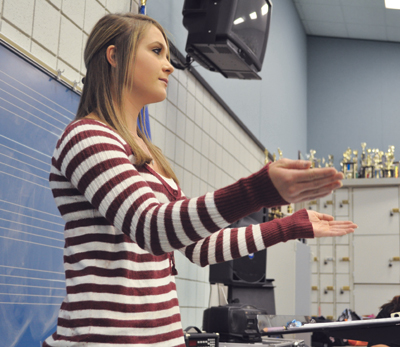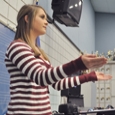
For the last seven years Lake Central High School has put on a student conductors concert each January. When I started teaching here, the first formal band concert of the year wasn’t until January. After a couple years I pushed it back into December. Although this worked well for a while, the gap between December and the next concert in April seemed too long.
On the December concert I always had one student conduct, so I decided to expand that to an entire concert of student conductors for the top two bands. We start rehearsing the day after the December concert, but with Christmas break factored in there are only three weeks to prepare, so the concert features lighter music.
I pick all the pieces and try to find music that will challenge the players and conductors. However, the music I select is easier than what we play for the April concert. I would not want to put music that is too difficult in front of a young, inexperienced conductor.
Auditions
For the audition students can choose a chorale out of our warm-up book or a 16- or 32-measure section from one of the pieces for the concert. Students all audition on the same day; I type up a list, and they go in the order I list them, usually alphabetically. I encourage the students who are playing to make notes about whose pattern is good and who is easy to follow. After everybody has auditioned, students vote for four students from the concert band, which is the second band, or five from the wind ensemble, the top band. This year 16 wind ensemble and 31 concert band students tried out. The directors have final approval of who is chosen.
After the choices are made, I assign students pieces based on their strengths. Students get a score to study during Christmas break. After break we spend the first couple rehearsals refining the pieces while the student conductors sit in a chair next to the directors. After a couple days we turn rehearsal over to them but stand nearby.
While they are on the podium I offer comments in front of the class, turning rehearsal into a short conducting masterclass for everyone. This includes taking a bow and teaching them to put a hand out and have the ensemble stand.
Student Struggles
The most common area students struggle is showing different sizes and styles of patterns. Many students look the same whether the music is soft, loud, legato, staccato, or marcato. I stress that on the podium students might think they’re using a variety of patterns and facial expressions, but any changes they make are usually barely noticeable. I think their faces tend to freeze because students are concentrating on getting the pattern correct to the exclusion of all else.
Once they become more comfortable I really dig in and work with them more intensely. I will roam around the room to watch or get behind them and offer suggestions while they rehearse. Sometimes I grab someone’s arm to show them to go bigger or smaller or to put more pop in the wrist. Given the limited amount of time before the concert, the intense correction is necessary. The students that audition are pretty serious about doing a good job, and they take criticism and suggestions extremely well.
Rehearsals
I let students make suggestions to the band if they notice something, and when I hear mistakes I ask if anyone heard anything. I may have them run a section again while I give a clue that someone might be dragging or rushing the tempo. Asking students what they thought the problem was gives them a chance to be introspective and think about what they hear.
Young conductors tend to gravitate towards hearing their instrument because that’s the dominant sound they hear in rehearsal every day. I ask, “Did you really hear clarinets there?” and when they admit they did not I ask them to try it again and listen for the clarinet melody.
At the Concert
I like to start the concert by saying, “You’ve seen these students play, march, and spin, and now you’ll see them conduct.” I introduce each band, but then I allow the student conductors to pick one of their friends out of the band to introduce their piece. I give a cue from backstage when the percussion is set, and the next two students come up, with the conductor standing by the podium and the friend reading the program notes and introducing the conductor.
During the concert I usually sit back by the timpani and watch. It’s rare as a conductor to have a chance to sit back and listen to your group. Obviously we listen from the podium every day, but to listen as a spectator is something that I wish we could do more.
Even though there is limited rehearsal time, I think students are prepared enough that the band falling apart is unlikely. I will say that sometimes watching the concert from offstage is nerve-wracking. I know that when I’m on the podium I’m in control, and if something went awry I feel confident that I could fix it, but when I’m backstage I can’t control much once the concert gets going.
At the end of the concert all nine conductors come back on stage and take their bows. This is also a photo opportunity for the parents.
The concert always goes over well with the community. The parents love seeing their children on stage, and for the band members it’s fun to see a different face on the podium. The audience loves the lighter music as well. There is always an enthusiastic response.
My goal is to get all students to the point where they can conduct a chorale or other warm-up exercises. Throughout the year I frequently have students conduct part of the warmup, including chorales, so many of them already know the basics of conducting, but a few students have been chosen to conduct on this concert every year they audition, and they graduate with a substantial amount of conducting experience for a high schooler. Students can do a lot when it’s asked of them, if they are supported and educated along the way.





